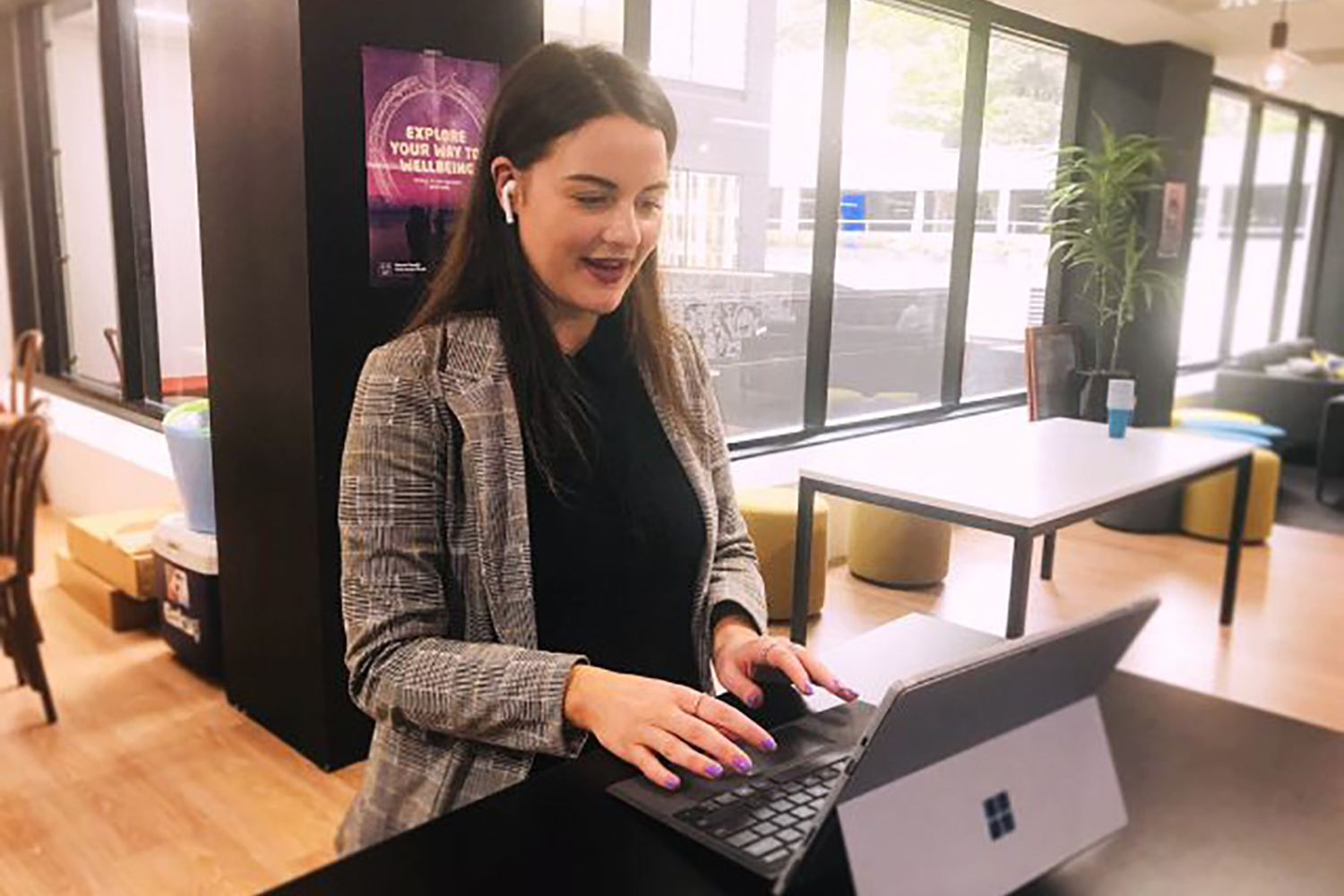Thinking About Video Interviewing?

Video interviewing isn’t something that’s new to our company, or our industry. What is new however is the version of video interviewing available in 2019 due to its evolution over past few years. Video interviewing was previously used for one thing only: a one person to one person, online interview. Usually this was done using Skype. To use this platform in the mid 2000s, you had to first download the software, and then go through the painful process of sharing IDs. At the end of the call, you endured several, long clumsy, seconds between when you would hang up and the call actually ending—anyone else remember those awkward pauses?! These days video interview platforms are streamlined and user friendly, with hundreds of options available.
As I talked about in a previous blog, in my role as National Business Improvement Manager, I have a focus on exploring technologies that may positively impact the recruitment experience for our clients and for our candidates. While we recognise that video interviewing may not be right for every role or every candidate, I wanted to challenge our business to try something new, and ultimately, provide our customers with more choice.
With this in mind, we have recently trialled Odro at Madison. This video interview platform is popular with recruitment agencies and it looked like it would be a good fit with the Madison culture. We were keen to understand how it might be able to use it, so we looked at the features, and identified the areas we were interested in:
Solo interviews also called pre-recorded interviews
Think of this as a pre-screening, before you interview a candidate, but via video instead. You create a list of questions you would like answered by candidates, and they respond in their own time, from any device they like. They can also do as many retakes as they want! No more phone tag, or awkward phone conversations with the candidate trying to communicate subtly that they can’t talk, as they are at work. Also, there are no log-ons required for candidates, so it’s super easy for them.
Virtual interviews and updates
We often expect candidates to take a significant amount of time off work, or pay for parking or travel costs to get to our offices. It’s how it’s always been, but isn’t always reasonable, or practical. Video interviewing allows us to meet prospective candidates face to face, without the need to be in the same room. This live interview feature allows users to conduct interviews with just one click, so no more sharing IDs.
In addition, we have been using features within the platform to send out personalised video messages to our candidates. This could be anything from wishing them luck for their first day on the job through to providing information about their assignment. Some Consultants have even used it to reach out to potential clients! There is also a Chrome extension meaning you don’t even have to leave the platform you are on, to get your message to your client or candidate.
Candidate presentation
When we present a profile or formatted CV of a potential candidate to a client, our Recruitment Consultants spend ages writing the perfect overview. Yet, we know that clients are already bombarded with written text. Often our candidates don’t stand out, and sometimes the best traits of the candidates get missed.
With this tool, the candidate is able to create quick video that is sent to clients along with the CV. Alternatively, Consultants can record themselves providing a quick overview on why the temp, contractor or perm candidate is suitable for the job—this saves time and is definitely more engaging than some words on a page.
Preparation for the platform
To prepare, we had group and individual training on the platform before it went live. Getting the free trial meant it was an easy sell for the business. Admin users received intensive training on how to use the analytics component, so we could measure user uptake. Once everyone was up and running, we ran competitions to encourage user adoption. There were bottles of wine, half days off, and team lunches up for grabs. I tried to communicate and provide updates via video messages myself. Like everyone, I was nervous recording myself the first time. I rerecorded my first update about 10 times and scrutinised every.single.word! By the third time, I was uploading a video without watching the full playback—which made me realise how quickly you can become comfortable with perceived ‘scary’ things, with just a little bit of practice.
Challenges faced
Like many businesses adding new platforms, we found that our existing technology and systems were not always at the level we needed. These were our main internal issues:
- For best practice use, the platform required a laptop, but many of our team work on desktop computers without cameras. While our business maintains a pool of laptops for everyone to use, the extra step of booking the laptop meant that it fell into the ‘too hard’ basket for some users, which is understandable.
- Our systems didn’t fully integrate. To complete a video interview, users needed to leave our CRM, log into the new platform and then manually upload it into the CRM. Of course this was possible, but again made it that little bit harder which isn’t great for user uptake and not the overall user experience we are aiming for (bring on our new CRM!).
- The WIFI speed in some offices wasn’t strong enough to record or playback videos which was challenging, and of course hindered user adoption.
Another consideration
There was one further barrier, which anyone who’s been through significant change and a change management process will be familiar with: pre-conceived assumptions and perceptions. In this case, the belief that candidates don’t like live video, or pre-recorded video interviews. While this absolutely might be the case for some candidates, when I probed further, some of this feeling was perhaps a little misguided. A common situation was to ask a candidate about their willingness, using a specific question format: ‘Do you like video interviews?’ Of course the candidate would be likely to say no—the same as they would if you asked them if they like interviews in general!
However, when the question was phrased differently, through focusing on the benefits and the option of video as a choice i.e. you don’t have to come in to our office, or you can answer the pre-recorded questions anytime of the day you like, it would yield different results.
Actively managing the change
Of course, adjusting to the requirements of video software is a normal concern. We did have a few instances where there were technological issues at the candidate’s end, as would be expected with any technology implementation. Not everyone is tech savvy. We know we’ll need to continue working on any negative perceptions of video interviewing being uncomfortable, or an extra step in the process. We’ll also need to prepare for the potential scenarios of poor audio or video quality that could mean the interview becomes time consuming, or awkward. Identifying these issues up front, means we will be prepared to deal with them.
Benefits
Despite the challenges, I believe the benefits outweigh these possible issues.
- Providing choice is the ultimate benefit.
- A reduced time to hire is realistically possible, especially in the volume space. Used well, this tool will reduce the time spent in several parts of the recruitment process.
- For some roles, e.g. customer facing positions, the video format naturally provides a useful view of the candidate’s suitability, at an earlier stage. A higher calibre of candidates at shortlisting stage is possible.
Personalisation wins
As a business, we are on a long term journey, striving to provide the best possible candidate experience. With this comes an understanding that what’s right for one candidate isn’t necessarily going to be right for another. I believe that where possible, we should provide choice. If a candidate is based not far from our offices and is keen to come in—perfect. However, if they have to take a chunk of time off work, travel, pay an exorbitant amount for parking just to meet with us, then perhaps video would suit them better.
Final decisions
We decided to purchase licences for half our consulting staff, and are working to ensure that Odro can link in with the new CRM partners that we are at the final stages of considering. With the video interviewing option becoming a solid reality, I know that many questions will be raised about using this format successfully; both for the interviewer, and interviewees. Watch out for a follow up post covering how to nail a video interview.
What are your experiences of video interviewing? Are you considering this approach for your business? I’d love to hear your views. Comment here or drop me a line at kerrie.gregory@madison.co.nz.

